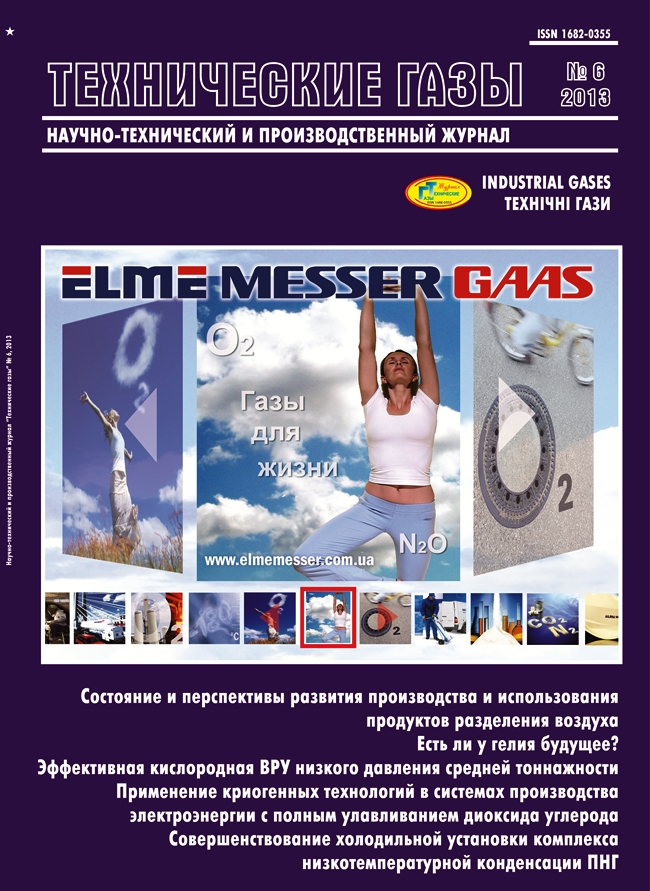СОВЕРШЕНСТВОВАНИЕ ХОЛОДИЛЬНОЙ УСТАНОВКИ КОМПЛЕКСА НИЗКОТЕМПЕРАТУРНОЙ КОНДЕНСАЦИИ ПОПУТНОГО НЕФТЯНОГО ГАЗА
DOI:
https://doi.org/10.18198/j.ind.gases.2013.0705Ключевые слова:
Холодильная установка, Пропан, Этан, Попутный нефтяной газ, Широкая фракция лёгких углеводородов, Рекуперация теплоты, Капитальные затраты, Эксплуатационные затраты, ЭффективностьАннотация
В существующих комплексах низкотемпературной конденсации при извлечении широкой фракции лёгких углеводородов (ШФЛУ) из попутного нефтяного газа (ПНГ) часто применяются внешние холодильные циклы. На их основе создаются компрессорные установки, работающие на пропане. Недостаток этих установок — производство холода на одном температурном уровне, что приводит к потерям от необратимости при охлаждении потока ПНГ в широком интервале температур. С целью уменьшения этой потери необходимо производить холод на нескольких температурных уровнях и снизить конечную температуру ШФЛУ. Для этого предложено в качестве рабочего тела использовать неазеотропную смесь пропана и этана (R290/R170). Для дальнейшего совершенствования установки в её схему были внесены изменения и включены дополнительные аппараты для обеспечения более эффективной регенерации тепла. Найдено оптимальное значение минимальной разности температур в процессах рекуперации тепла, соответствующее минимуму суммарных затрат на модифицирование установки. Показано, что по сравнению с пропановой установкой выход ШЛФУ в модифицированнной установке возрастает на 5 %, что позволит окупить дополнительные инвестиции в срок не более года.
Библиографические ссылки
Ataei A. Chang K.Y. (2010). Сombined pinch and exergy analysis for energy efficiency optimization in a steam power plant// International Journal of the Physical Sciences. — V. 5. — No. 7. — P. 1110-1123.
Ataei A. (2011). Application of combined pinch and exergy analysis in retrofit of an olefin plant for energy conservation// Scientific Research and Essays. — V. 6. — P. 2437-2446.
Kemp I. C. (2007). Pinch analysis and process integration. – UK: IChemE, — P. 396
Feng X., Zhu XX. (1995). Combining pinch and exergy analysis for process modifications// Applied Thermal Engineering. — No. 17 — P. 250-260.
Martynyuk M.O., Khmelnyuk M.G.(2009). Analysis of characteristics of propane refrigerating compressor such as type «TP5-5» at its work on a mixture propane/ethane// Tekhnicheskie Gazy [Industrial Gases]. — No. — 4. — P. 23-28. (Rus.).
Kwak HY. Exergic and thermoeconomic analysis of power plant// Energy. — 2003. — No. 28. — P. 343-360.
Smith R. Chemical Process Design and Integration. — UK: John Wiley & Sons Ltd, 2005. — 714 p.
Загрузки
Выпуск
Раздел
Лицензия
ЛИЦЕНЗИОННЫЙ ДОГОВОР
После приёма статьи к публикации редакция согласно требованиям наукометрических баз каждому из авторов направляет лицензионный договор об уступке и передаче в управление авторских прав. Подписи автора (авторов) желательно скрепить печатью отдела кадров учреждения, в котором работает автор (авторы), или печатью факультета.
Редакция отсылает авторам одну верстку для корректуры. Допустимы лишь те исправления, которые приводят верстку в соответствие с исходным текстом статьи. Внесение существенных изменений не допускается. Верстку следует выслать в редакцию в течение суток с момента получения.

